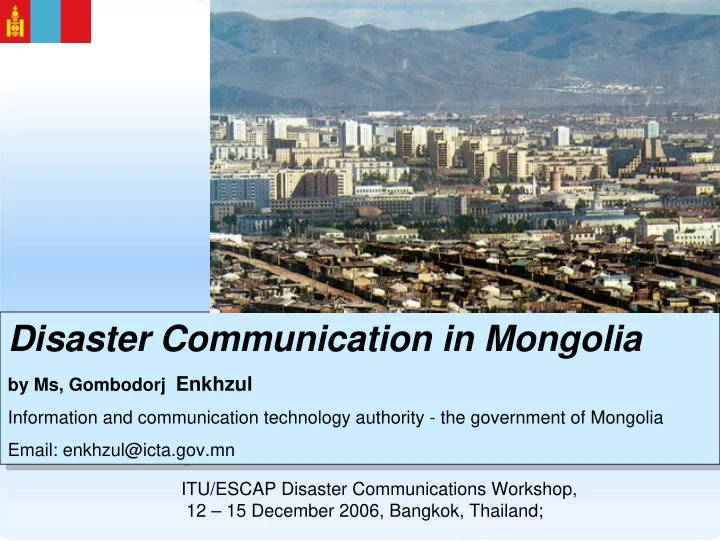

Disaster Communication in Mongolia Disaster Communication in Mongolia by Ms, Gombodorj Enkhzul by Ms, Gombodorj Enkhzul Information and communication technology authority - the government of Mongolia Information and communication technology authority - the government of Mongolia Email: enkhzul@icta.gov.mn Email: enkhzul@icta.gov.mn ITU/ESCAP Disaster Communications Workshop, 1 12 – 15 December 2006, Bangkok, Thailand;
Country profile • Mongolia is a landlocked country in Northeast Asia located between Russia and China. • Area: 1,564,116 km² • Population: July 2005 estimate 2,646,000 • GDP: Total $5.56 billion 2 end
Observations and findings on disaster management in Mongolia • Drought and DZUD, snow and dust storms, forest and steppe fire, human and animal highly infectious Drought Drought diseases, flood, earthquake, chemical and radioactive substance release, major technical accidents are frequent occurrences. DZUD is a Mongolia-specific winter disaster which undermines the welfare and food security of the herding community through large-scale death and debilitation of livestock. dust storms, blizzards • Extremes in climate and difficulties caused by social and economic transition have also contributed to the current disaster situation. Storm Storm 3 end
Disasters Drought Drought Dust storm Dust storm DZUD DZUD Snow storm Snow storm Storm Storm 4 end
Current condition • Report by the General Emergency Authority, a total of 1,249 devastating natural phenomenon and disasters occurred in Mongolia in the first five months of this year. As their consequences, – 50 people lost lives, – 556 gers (traditional portable dwelling) and houses were burnt out, – 6.2 thousand heads of livestock perished. – Animal contagious rabies occurred 17 times, livestock contagious foot- and-mouth disease--one time, and the anthrax--four times. During the last five months, earthquake and strong storm occurred four and five times respectively, – 91 forest and steppe fires broke. – The disasters caused damage of 1,047.9 million togrogs. Since 1999-2002, more than 50 per cent of the territories of Mongolia was occupied by drought, it was an occasion in the last 60 years. Those were coupled with an increase in the frequently of natural disasters. This unfavorable climatic condition on of the factors, exerting an adverse effect on Mongolian social and economic development. 5 end
Leading and related organizations • National Emergency Management Authority /2004, Jan/ – Responsible for all the disaster management, reduce disaster, fight for the fire and country’s resource • Information and Communications Technology Authority (ICTA) was established in 20th October 2004. – The Authority is responsible for all ICT policies, coordination and implementation under the direct auspices of the Prime Minister of Mongolia and ICT sector has been given a great priority and is regarded as the leading direction of the Government development strategy • Information and Computer Centre at the Institute of Hydrology and Meteorology, Ministry of Environment and Nature – The mapping of forest and wild fire and meteorological disaster situations is worked out • Research Center of Astronomy Geophysics 6 end
National Acts • “Law on Disaster Protection” specified the rights and responsibility of the private sectors, civic societies, nongovernmental and scientific organizations, as well as the mass media in the matters. /2003.June, 20 / • “National programme on natural disaster reduction” • “National programme on the prevention of desertification” • “National programme on weather changes”, • “National programme on forestry” 7 end
Communication system Good Communications are one of the most essential factor for dealing with emergency or a natural disaster, effective communications require appropriate and reliable equipment, infrastructure, and a good management. • Communication system of emergency Services – Telephone network – Radio communication – Mailing service – Intranet – Satellite communication – Disaster alarm system 8 end
Telephone network 9 In year 2006, cellular subscriber became / 615025/
Cellular mobile communications Cellular mobile communications 10
Call center – Dial 105 • Anytime when disaster occurs or emergency situation you can call 105 . 11 end
12
National Emergency Management Upload Agency Sitellite & Sitellite Download Public & Internet Internet Telephone Network PTN Receive from HF DATA DPA Download Upload Wired or Wireless ATC Connector Optic Cable HF DATA Emergency Management Division Disaster prone area Mobile (DPA) Emergency Staff UHF UHF Rescue Call to PTN Unit 2 13 Rescue Unit 1
end 14 Disaster operation
Disaster warning system • Before 1990 our country has Civil Defense warning system /5F88/ but it is not maintenance fulfill from technical underdevelopment and other reasons. We don’t have any independent disaster warning system now. • Disaster warning system depends on any other infrastructure such as power supply, information communication system and if this infrastructure is not activity therefore the warning system doesn’t work, too. Therefore it is necessary to establish central and group administrative disaster warning system, which not depending on other infrastructure. 15 end
16 National transmission network system
Purpose • Establish and implementing new Disaster warning system in the capital city and other provinces. Improve the activities relating with the management for the prevention of disaster. • Use effectively GIS remote sensing utility, early warning • Strengthening the radio communication capacity of disaster management • Flood warning system for capital city • Organize training course for the staffs how to use ICT when disaster occurs. • Connecting to the satellite system 17 end
Contact: Information and communication technology authority- The Government of Mongolia Fax: 976-11-330780 Phone:976-11-330781 Email: enkhzul@icta.gov.mn Web: www.icta.gov.mn 18 Home
Recommend
More recommend